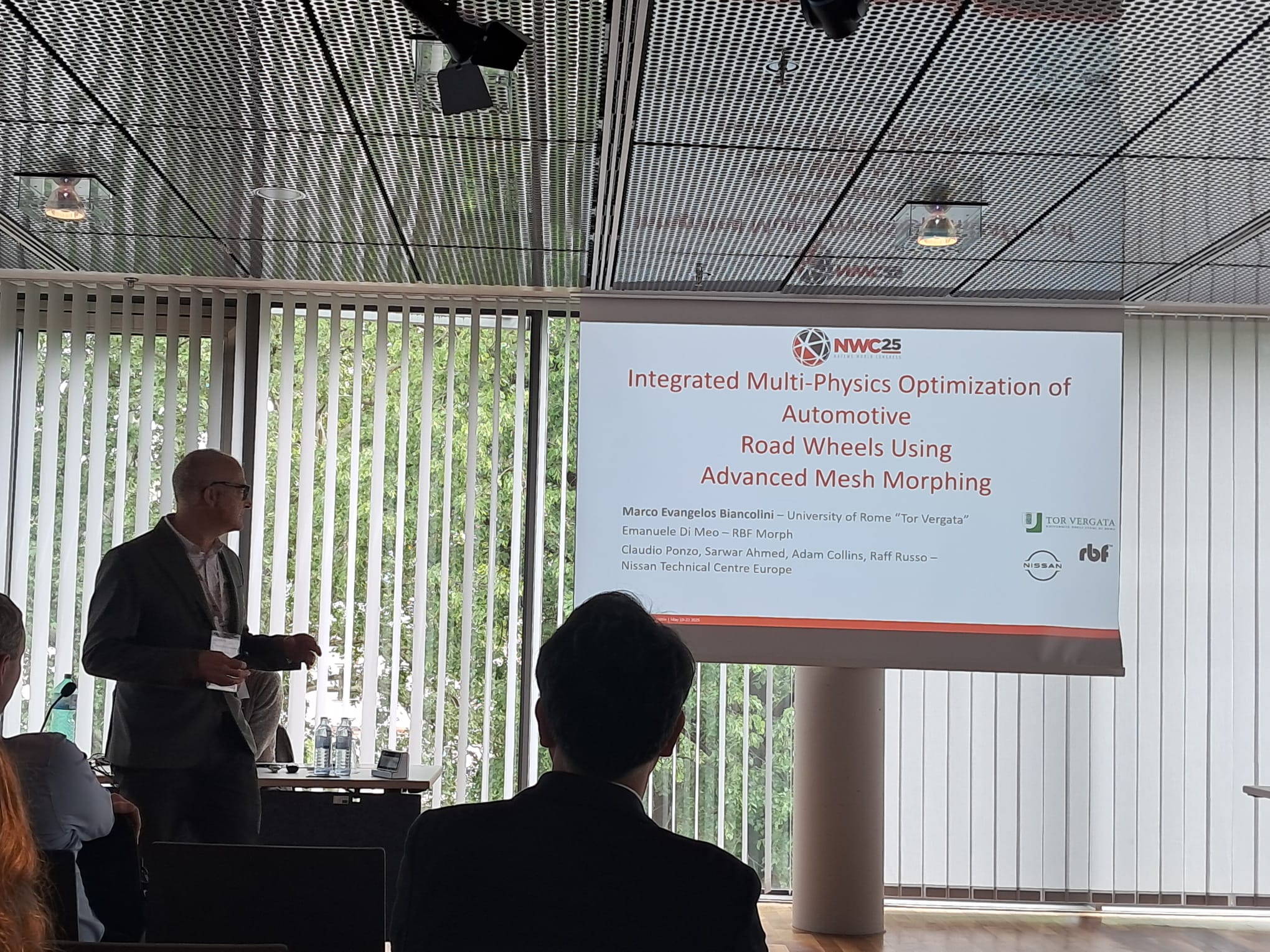The NAFEMS World Congress 2025, held in Salzburg, Austria, concluded with compelling discussions and demonstrations at the intersection of simulation and artificial intelligence. Among the highlights was a presentation by Professor Marco Evangelos Biancolini, founder of RBF Morph, introducing the capabilities of the newly launched rbfCAE platform.
Presentation: “Integrated Multi-Physics Optimization of Automotive Road Wheels Using Advanced Mesh Morphing”
Developed through a collaboration between the University of Rome Tor Vergata and Nissan Technical Centre Europe, the study demonstrated a complete multi-physics optimization workflow for an 18-inch electric vehicle (EV) road wheel. The workflow integrates NX Nastran (FEA) and HELYX (CFD) solvers through the rbfCAE platform, without requiring any re-meshing—dramatically improving efficiency and design fidelity.
Technical Highlights
The rbfCAE platform enables seamless integration across FEM, CFD, and FSI solvers, creating a unified workflow for complex simulation tasks. One of its most notable advantages is the ability to update geometry without the need for re-meshing, which both preserves mesh topology and significantly accelerates iteration cycles. Through iso-brep CAD morphing, the platform ensures that design constraints, such as those related to vehicle styling, are maintained throughout the optimization process.
Additionally, rbfCAE supports both parametric and BGM-based morphing approaches, allowing for flexible shape optimization—whether defined by the user or driven by stress distribution data. Its architecture is also designed with future technologies in mind, making it compatible with Reduced Order Models (ROMs) and Artificial Intelligence for real-time simulation and Digital Twin applications.
Case Study Results
In the case study presented, the optimization of an 18-inch electric vehicle wheel resulted in a measurable reduction in weight, with each wheel made 0.4 kilograms lighter. Stress levels were kept safely below the material’s yield strength, ensuring structural integrity. While there was a minor increase in drag coefficient—from 0.302 to 0.305—a notable improvement in rear downforce was achieved, contributing to enhanced aerodynamic stability and overall vehicle efficiency.
This project clearly demonstrates rbfCAE’s potential to deliver fast, scalable, and high-fidelity optimizations across multi-physics domains. Its benefits are particularly impactful in the design of electric vehicles, where efficiency and performance must be balanced with strict constraints.
Looking Ahead
The roadmap for rbfCAE includes several advanced developments. Integration with artificial intelligence will allow for real-time design exploration, further accelerating innovation cycles. The platform’s capabilities will also be extended to support full-vehicle optimization workflows, including dynamic interactions between components such as wheels, flow fields, and suspension systems. In addition, the introduction of immersive tools like rbfVR will enhance the user experience, enabling interactive and intuitive design review environments.
You can view the complete presentation here.


13 Comments
buy cheap androxal generic is good
ordering androxal purchase to canada
how to order androxal cheap europe
purchase rifaximin to canada
ordering rifaximin purchase usa
how to order rifaximin generic name
discount enclomiphene cost uk
purchase enclomiphene buy dallas
buy enclomiphene cheap canada pharmacy
medicament kamagra medicament
acheter kamagra sans prescrire france
kamagra meilleur prix
can you buy dutasteride in mexico
online order dutasteride generic efficacy
discount dutasteride mastercard buy
purchase flexeril cyclobenzaprine cheap canadian pharmacy
purchase flexeril cyclobenzaprine cheap from canada
flexeril cyclobenzaprine canada
get gabapentin without a script
how to order gabapentin ireland over the counter
ordering gabapentin without rx online
online order fildena online mastercard accepted
cheapest buy fildena usa where to buy
buying fildena price in us
how to order itraconazole cheap melbourne
get itraconazole uk delivery
cheapest buy itraconazole buy singapore
online order staxyn generic staxyn
cheap staxyn generic available
staxyn prices walmart
buying avodart price netherlands
buying avodart uk no prescription
get avodart cheap trusted
order xifaxan australia where to buy
cheapest buy xifaxan cheap real
cheapest buy xifaxan generic uk
cena kamagra vs
sobotní doručení kamagra lékárnické
kamagra online doručení druhý den